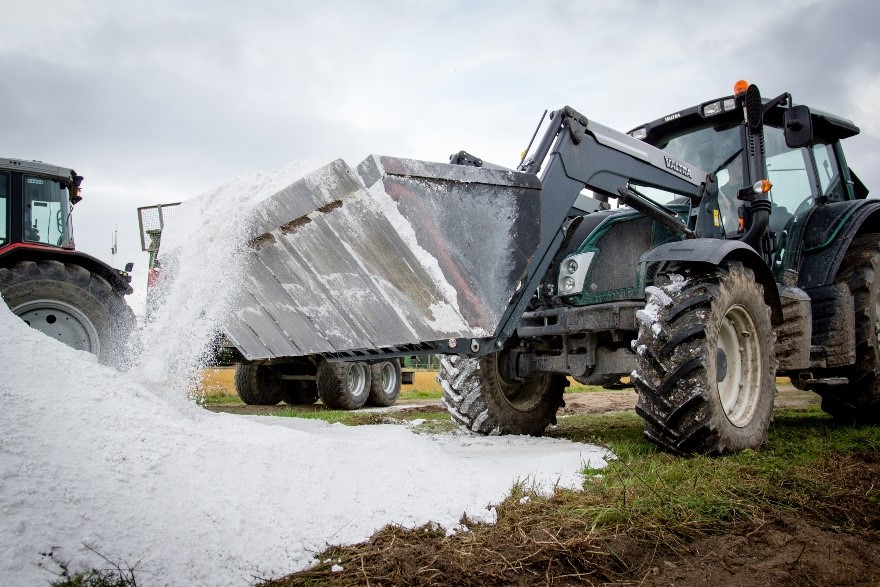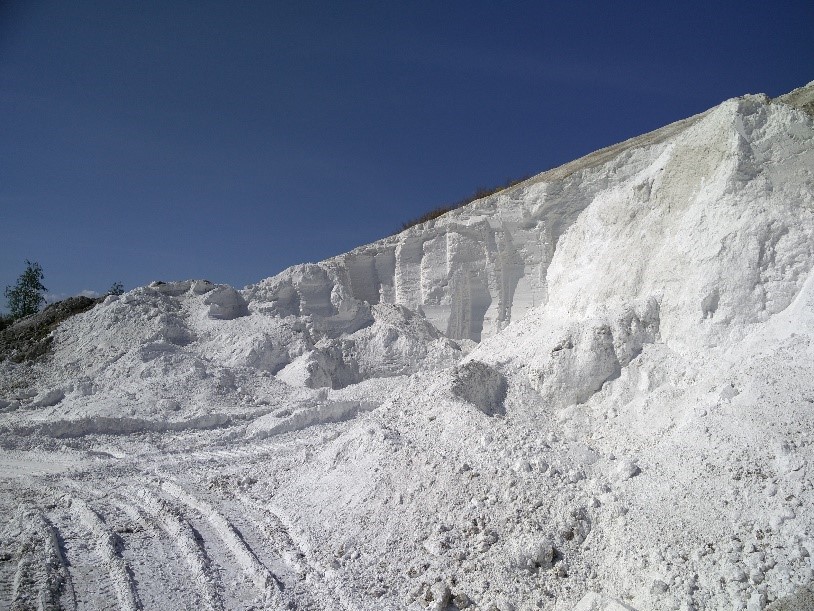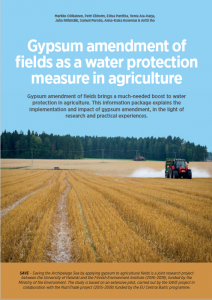
Project coordinator
University of Helsinki
+358 2941 58061
eliisa.punttila (a) helsinki.fi
Gypsum is calcium sulfate dihydrate (CaSO4∙2H2O). As a soil amendment, it significantly reduces agricultural phosphorus load and erosion. Gypsum amendment as an agricultural water protection measure has been investigated at various scales in Finland in the recent ten years. The innovation was first tested in a laboratory, followed by the field trials and finally by a large-scale pilot implemented in our project. Today, the first steps are taken towards the extensive use in Finland.
Gypsum amendment is a promising measure for reducing agricultural phosphorus load also in other Baltic Sea countries and elsewhere in the globe. From the viewpoint of general applicability of gypsum amendment, sources of suitable gypsum should be found locally. Gypsum has global markets mainly for the purpose of construction industry. But what kind of gypsum is suitable for agriculture?

Quality and availability of gypsum matter
When gypsum is used in agriculture, the purity of gypsum is important to take into account. Gypsum should not contain harmful concentrations of heavy metals or other hazardous impurities, since they accumulate in the soil and crops and threaten food safety. Therefore the quality of gypsum is necessary to verify with content analysis before use in agriculture.
Since gypsum is available from various sources, it may also contain a notable share of other substances, for example calcium carbonate or wood-based products. In agricultural use mixtures of gypsum and other materials may have differing impacts. In order to ensure the water protection effect and to avoid the unwanted side effects, the suitability of gypsum mixtures for agriculture should be tested before use.
Gypsum is moderately soluble to water, about 3 grams per litre. The smaller grain size gypsum has, the faster it dissolves into the soil water. In some countries very fine gypsum is spread even via irrigation system. Gypsum may also refer to calcium sulfate anhydrite or hemihydrate, which do not contain two bounded water molecules and hence dissolve slowlier to water.
Gypsum provides efficient phosphorus reductions with lower costs than any other water protection measure currently used in agriculture. According to the tests in Finland, suitable dose of gypsum is 4 tons per hectare. In a large-scale pilot in 2016 gypsum was transported from eastern Finland to southwestern Finland (about 500 km) by 144 truck loads. The total cost of gypsum amendment was 220 euros per hectare. In reducing phosphorus load from agriculture, the cost was 60–70 euros per kilo of P – significantly less than costs of other currently available measures.
The cost-effectiveness of gypsum measure depends highly on the availability and costs of gypsum as well as transportation costs.
Also, the way gypsum treatment of soil is performed matters. The soil type, the cultivation practices as well as weather conditions all have influence on the impacts of gypsum on soil. Thus, more research is needed of the impacts of gypsum amendment, with different sources of gypsum and in varying field conditions.
Different sources of gypsum
Here we list the most typical sources of gypsum potentially available for agricultural purpose:
Phosphogypsum. The gypsum used in the Finnish soil amendment studies is a by-product originating from Yara’s phosphorus acid industry in Siilinjärvi, eastern Finland. This phosphogypsum’s availability is good, since it is produced 1.3 million tons annually and it does not have any major use. Gypsum from Siilinjärvi is free of hazardous substances, since the process uses apatite from a magmatic source.

Globally, the possibilities to utilise phosphogypsum are restricted due to possible content of heavy metals or radioactivity. Still, it might be possible to purify this kind of phosphogypsum from harmful substances and use it in agriculture, if technologies to purify gypsum were developed.
FGD gypsum. Another industrial and commonly known by-product gypsum is FGD gypsum (flue-gas desulfurization). It is a by-product from energy industry, originating from a process of purifying sulfur oxide from fossil-fuel power plant emissions. FGD gypsum is common in the USA, where gypsum is a well known soil amendment.
Recycled gypsum. Gypsum is a recyclable material. Gypsum from finely grounded wallboards is also a suitable material, used for example in the USA.
Mined gypsum mineral. Gypsum is also a natural mineral, which is mined globally. Mined gypsum is suitable for organic farming. However, use of industrial by-products and recycled gypsum can support circular economy.


